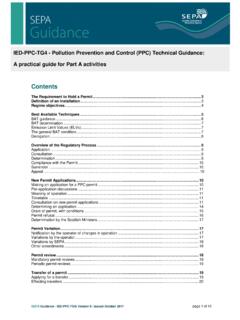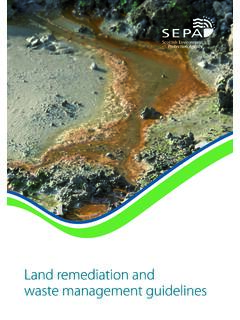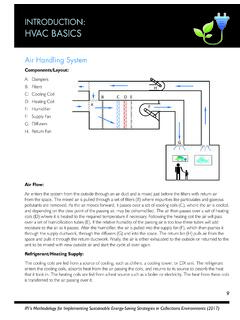Transcription of The chemistry of air pollution
1 The chemistry of air pollutionContentsAir is very important as it provides oxygen and other gases that are essential to all life on Earth. 78% NitrogenNIt consists of a mixture of invisible gases that surround the small amounts of other trace gases, such as carbon dioxide and vapourtrace Carbon monoxideCOtrace Nitrogen dioxideNO221% ArgonArOther gases(Less than 2%)Oxygen(21%)Nitrogen(78%) Carbon dioxideCO2 Clean air is vital to sustain the delicate balance of life on pollution occurs when certain gases and particles build up in the atmosphere to such levels that they can cause harm to our health, causing breathing and respiratory problems, and even resulting in premature death, as well as damaging the environment around us.
2 These gases and particles (known as pollutants) tend to come from man-made sources, including the burning of fossil fuels such as coal, oil, petrol or diesel, but can also come from natural sources such as volcanic eruptions and forest the quality of air can be affected by air can be in the form of:solid particlesliquid droplets gasesVolcanoesWildfiresPrimary pollutantsCarbon monoxide COCarbon dioxide CO2 Sulphur dioxide SO2 Nitric oxide NONitrogen dioxide NO2 Hydrogen peroxide H2O2 Secondary pollutantsSulphur trioxide SO3 Nitric acid HNO3 Sulphuric acid H2SO4 Ozone O3 Volatile organic compounds VOCsParticulates (PM)Ammonia NH3 particulates (PM)Power generationVehicle exhaustsAeroplanesFactoriesAgricultureAi r pollutants can be classified as: Ammonium NH4+A primary pollutant is one that is emitted directly from a source.
3 Secondary pollutants are formed when primary pollutants interact with each other in the main primary pollutants areCOCarbon monoxideCarbon monoxide (CO) is a colourless, odourless, and very poisonous is formed as a by-product of incomplete combustion processes involving carbon based energy sources, such as the burning of petrol, coal or wood. During the process, if there is not enough oxygen available to create carbon dioxide as a by-product, then carbon monoxide is created monoxide is dangerous to humans, once inhaled it competes with oxygen by attaching on to haemoglobin in red blood cells and starving vital organs such as the brain, nervous system tissues and the heart of oxygen, reducing their ability to work biggest sources of carbon monoxide comes from vehicles, especially when they are moving slowly or when the engine is dioxideNitrogen oxides (NOx)
4 Are a group of gases made up of varying amounts of oxygen and nitrogen molecules. One of the most common nitrogen oxides is nitrogen dioxide (NO2) which is a reddish, brown gas that has an unpleasant smell and is poisonous in high concentrations. They are formed when fossil fuels are burned at high temperatures, but can also be formed naturally by lightning strikes. NooIt can increase the likelihood of respiratory problems, as it inflames the lining of the lungs, and can reduce immunity to lung infections. This can cause problems such as wheezing, coughing, colds, flu and of the nitrogen dioxide in urban areas comes from exhaust emissions.
5 These can form secondary pollutants and can result in environmental problems such as acidification and nitrogen enrichment. SO2 Sulphur dioxideSulphur oxides (SOx) are a group of compounds made up of sulphur and oxygen molecules. The most common sulphur oxide is sulphur dioxide (SO2), which is a colourless gas with a burnt match type smell. They are formed during the burning of fuels containing sulphur, such as coal and oil, and metal-containing ores (including aluminium, copper, zinc, lead and iron).Most of the sulphur dioxide in our air is caused by the burning of coal and oil for energy generation and industrial activities.
6 It is also produced from natural sources such as active volcanoes and hot dioxide can cause breathing difficulties if inhaled into the body. It is also toxic to plants and can cause acid rain when it reacts with moisture in the can form secondary pollutants and can result in environmental problems such as or particulate matter (PM) are tiny pieces of solid matter or liquids in the air, and can consist of hundreds of different chemicals, including carbon, sulphur, nitrogen and metal compounds. They originate from many different sources, including construction sites, vehicle exhausts, industrial sites, unpaved roads, and come in many shapes and sizes.
7 Some are large enough to be seen with the naked eye, whereas others can only be seen through powerful particles (larger than 10 micrometers) are generally filtered out of the body via the nose and throat. Particles that are 10 micrometers or smaller can be inhaled into the deepest parts of the particles are smaller than micrometers and are small enough to pass from the lungs into the blood particles< m eachHuman hair 50 mFinest beach sand 90 mPM10 particles<10 m eachNH3 Ammonia (NH3) is a very soluble colourless gas with a strong pungent is primarily released from animal waste and fertiliser use, vehicle exhaust and other processes.
8 This forms secondary pollutants with the acid pollutant of SO2 and NOx to produce ammonium (NH4+). These can then be move by the air over large distances from the initial biggest source of ammonia release is from agriculture including the intensive rearing of animals and ammonia and the ammonium pollutants fall to the ground, they add to the nitrogen enrichment effects, increasing the growth of some plants, including pollutants O3 Ground level ozoneO3O3 Ozone can cause irritation to the respiratory tract and eyes, causing chest tightness, coughing and wheezing.
9 Especially amongst those with respiratory and heart also is a damaging air pollutant to plants, as it reduces growth and productivity including food crops. Ozone (O3) also affects buildings and building level ozone (O3) is a colourless gas that is a major component of atmospheric can actually smell ozone from your fresh washing if it s left out during a hot day or after a heavy thunder storm!O3O3O3O3O3 Primary pollutants can be transported over long distances by wind, generating ozone, meaning that rural areas can experience high ozone is formed by chemical reactions between nitrogen oxides (NOx) and volatile organic compounds (VOC) in the presence of ground level ozone also comes from higher in the rain Acid rain is formed when sulphur dioxide (SO2) and nitrogen dioxide (NO2) react in the atmosphere with water, oxygen and other chemicals to form various acidic compounds.
10 These compounds are transported in the air by the wind, until they fall to the ground in either wet or dry form. SO2 NOxSO2SO2 NOxNOxWhen the compounds fall to the ground, they can cause damage to plants, including trees. They can also increase the acidity levels of our soils, rivers, lochs and streams, affecting the delicate balance of ecosystems that live in these pollutants that cause acid rain - sulphur dioxide and nitrogen dioxide can also be damaging to human health. As these gases interact in the atmosphere, they can form fine sulphate and nitrate water droplets which can irritate the air ways and cause irritation to eyes.















